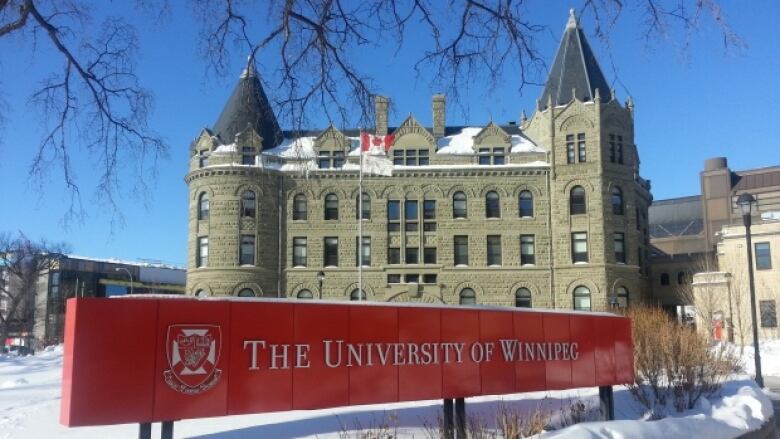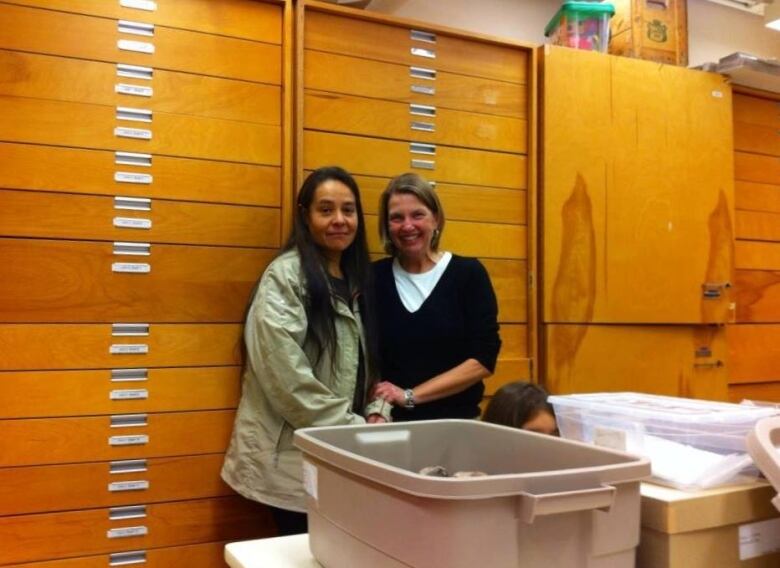Remains from 145 Indigenous ancestors in storage at University of Winnipeg
U of W working to repatriate remains, but say it takes time and must be done with sensitivity

The University of Winnipeg has been working to repatriatethe remains of Indigenous people stored on campus, but at least one Indigenous woman says it's not happening fast enough.
Remains from about 145 Indigenous people are currently in storage at the university, according to a University of Winnipeg statement sent to CBC News. They range from a single tooth or bone fragment to a partial or complete skeleton.
The university says most of the remains were unearthed by third parties, who transferred responsibility for them to the school.
"They are in safe custody and not on public view or used for teaching purposes," the statement says.
The university said it, along with the province's Historic Resources Branch (HRB), has reached out to "several First Nations Knowledge Keepers" on how to move forward with repatriation efforts.
One of those knowledge keepers is Diane Maytwayashing, an Anishinaabe educator who was involved in repatriation efforts of the remains of six Indigenous ancestors near her home in the Whiteshell area in 2013.
Maytwayashing said she was contacted in the spring by Kevin Lamoureux, the university's associate vice-president of Indigenous affairs, who asked her for help with repatriating additional remains due to her previous experience.
However, she said she is frustrated by how long it is taking to repatriate the rest of the remains.

"There was no meetings, just the passing of tobacco, and that was it," she said, adding the lengthy bureaucratic process "wasn't very comfortable."
"It was like, why can't I just walk out of there with my grandmothers and my grandfathers and put them back in the earth? It's crazy."
The university said the remains of 18 individuals were repatriated in 2017, and six more are scheduled for repatriation in the spring of 2018.
Academic knowledge
It's not just the University of Winnipeg that has Indigenous peoples' remains in its possession, said Lamoureux, who is currently seconded at the National Centre for Truth and Reconciliation for a year-long term.
Many academic institutions across Canada are in possession of remains, he said. They typically go to universities or museums when discovered during construction or farming, he said.
"Some of them definitely, and let's not hide away from this, were collected by anthropologists thinking they were doing good science, which kind of makes my stomach turn," said Lamoureux.
He added that the majority of the remains at the University of Winnipeg were unearthed by Manitoba Hydro and transferred into the care of the university.
"I can't speak to the mindset that would have allowed universities to accept that," he said.
He said he understandsMaytwayashing'sfrustrations, and believes the university should not be holding any Indigenous remains.
"It's 100 per cent inappropriate."
Maureen Matthews, the Manitoba Museum's Curator of Ethnology, said communities aren't always able to accept remains or other artifacts for a variety of reasons, including a loss of ceremonial knowledge at no fault of their own, or lack of resources.
She also said there is a scientific community that argues studying human remains has provided knowledge.
"It's worth getting into that argument because there are things that have been found out," she said.
"For instance, they worked out whether or not certain diseases were North American or were they introduced, that kind of thing, and the only way to know is to check the bodies of people who died before."
The flipside of that argument, she said, is that years of mishandling may have contaminated remains being studied. Matthews said she believes remains should be returned to communities that want them back.

'It does take time'
Repatriation efforts have been taking place in O-Pipon-Na-Piwin Cree Nation in northern Manitoba since the early 1990s, said resident Leslie Dysart. However, he said those efforts haven't always been handled sensitively.
"My mother, she was given a box," he said, from the Historical Resources Branch.
"I guess they somehow traced the DNA back to her. She figured it was her older brother."
His mother wasn't informed the remains were coming, nor was there any ceremony around the handover, he said.
Things have improved since then, said O-Pipon-Na-Piwin Cree Nation executive director Mike Dumas.
The University of Winnipeg, along with the HRB and the Manitoba Museum, have returned remains to the community every couple of years since the early 2000s, said Dumas, describing the returns now as a "partnership."
"It does take time," he added. "It takes a couple of years. But that time has been cut way in half from what it's been."
Dumas said the university has taken the lead and consults with the community's elders when remains are returned. Repatriated remains are generally thought to be the relatives of the people who are currently living on or near the land where they're found, and they're buried at a site in the community.
Their relatives and local elders participate in the ceremony, he added.

The right to repatriation
Ry Moran, director of the National Centre for Truth and Reconciliation, said honest, open and difficult conversations need to start happening.
"The UN Declaration on the Rights of Indigenous Peoples (UNDRIP) confirms the rights of Indigenous peoples to protect and preserve their history, and that includes the right to repatriation," he said.
"Canada as a nation state only adopted UNDRIP last year. And we as Indigenous peoples continue to live in a society wherein those rights remain largely unarticulated."
Lamoureux said the University of Winnipeg has a history of failing to repatriate remains in a timely and caring fashion, "so we have to own that."
But the process of repatriation can still be a long one, involving community partnerships, consultations with Indigenous leaders and ceremony, as well as complying with the province's laws surrounding the housing and moving human remains.
In the meantime, the university is responsible for caring for the remains respectfully until they can be claimed by their home communities.
Community members can and do come to campus to hold ceremonies with their ancestors, the university said, and at least twice a year it also invites elders to lead a ceremony with smudging, praying and singing with the ancestors' remains.
Lamoureux said his goal is to repatriate all the remains in the university's possession.
"We have the support of administration," he said.
"No one wants to be holding on human remains on campus."
Corrections
- In a previous version of this story, a statement that the University of Manitoba had Indigenous remains was mistakenly attributed to Kevin Lamoureux. Lamoureux said he cannot confirm that.Nov 20, 2017 10:08 AM ET












_(720p).jpg)


 OFFICIAL HD MUSIC VIDEO.jpg)
.jpg)



























































































